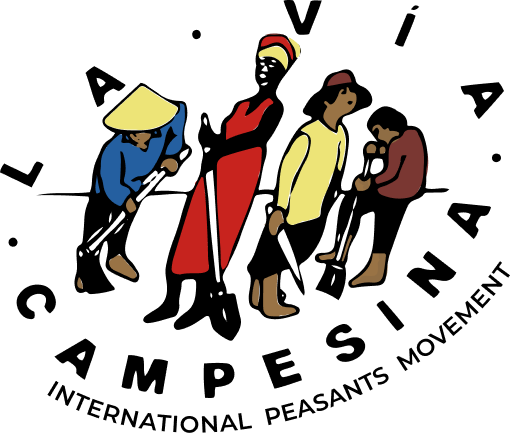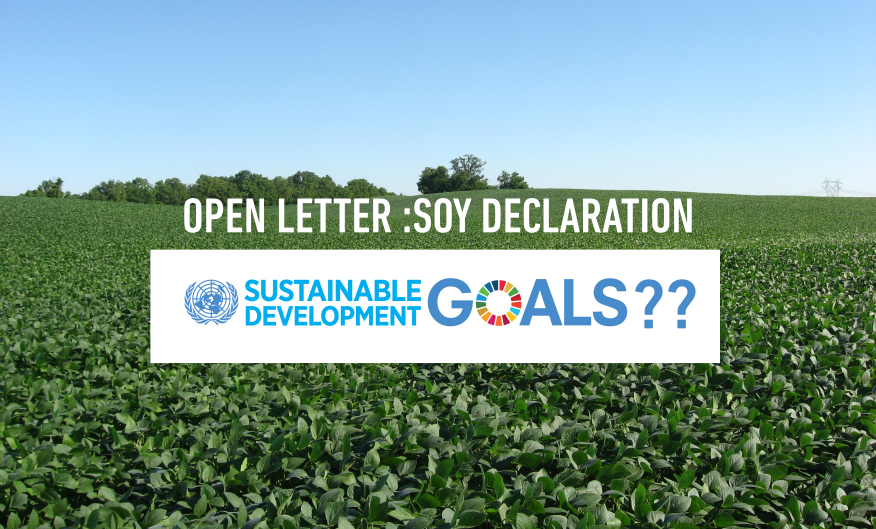 This week the European Coordination Via Campesina addressed an open letter to the Ministers of the AGRIFISH Council -scheduled to meet from 17-18 July- asking them to reject the European Soy Declaration.
This week the European Coordination Via Campesina addressed an open letter to the Ministers of the AGRIFISH Council -scheduled to meet from 17-18 July- asking them to reject the European Soy Declaration.
The claims of this Declaration, tabled by Germany and Hungary at the Farm CounIholdings within the EU. Their produce is also vital within the global food system(v). Soy is not a crop suited for European small-scale farmers, and furthermore, it has become an agro-industrial crop. Any consideration of soybean production cannot be made in the absence of the industrial-scale network of actors that comes with it(vi). The production model associated with modern soy cultivation is both intensive and expansive; there is little scope for benefits to be gained by small-scale producers. With access to CAP subsidies based on size of holding, the larger producers embedded within the soy industry have further incentives to land concentration. Thus, small-scale producers face the prospect of further marginalisation through increased concentration of agrarian land in fewer hands. Small-scale producers in Central and Eastern Europe are particularly vulnerable given the high soil quality and cheaper land prices in the region, in combination with the presence of direct payment schemes. This issue has already been recognised as a high priority by the European Parliament. In April of this year, an own-initiative report was voted through by an overwhelming majority, detailing the urgent need to tackle land concentration in Europe(vii). In addition, EU member states have subscribed to implement the U.N. “Voluntary Guidelines on the Responsible Governance of Tenure” (viii). Allowing the soy industry to take root in Europe would counter the effective fulfilment of these guidelines.
Rural employment
The idea that protein crop production will benefit rural economies is further contravened by the structure of the soy industry. Profitable upstream and downstream segments of the chain are controlled by a select small group of large agro-industrial corporations(ix), leaving little room for the promise of regional development. The profit-driven nature of the global soy industry has proven to disadvantage rural communities elsewhere, and importing this model to Europe is not going to change this. In addition, there is little evidence to support claims of local job creation through soy production, not only from South American examples, but also within the EU. The likely geographical disparity between the location of European production and the location where the profit is concentrated, almost mirrors the situation in South America. Demonstrative of this is the distribution of members of schemes such as the Danube Soy Initiative; all of the 14 producers are located in Central and Eastern Europe, with 9 of these in Romania(x), and with many of these firms being subsidiaries of western European investors. By contrast, processors and traders in the scheme overwhelmingly originate from Western Europe, exhibiting an imbalance that bypasses rural economies in Central and Eastern Europe. The combination of increasing land concentration, poor alternative rural employment opportunities and a neo-colonial industry model, has severe implications for the food sovereignty and food security of rural communities in production areas. Once again, this scenario challenges the claim that SDG 2 can be addressed through the cultivation of soy in Europe.
Sustainable Development Goal 15
Environment
Further concerns with the ‘European Soy Declaration’ relate to the environmental impacts of industrial scale soy production in Europe. The pesticide and herbicide use associated with it has brought colossal environmental consequences for valuable ecosystems in Latin America, as well as for human wellbeing(xi) (xii). The extensive application of agrochemicals is a critical environmental issue linked to the cultivation of soy, with negative implications for water quality and biodiversity. Aside from the detriments of heavy chemical inputs, the imposition of large soy expanses in European landscapes provides a further threat to biodiversity. Therefore, the proposition that the ‘European Soy Declaration’ can contribute to SDG 15 is flawed. The large-scale expansion of an industrially farmed crop does not align with the promotion of ‘sustainable use of terrestrial ecosystems’ or attempts to ‘halt biodiversity loss’ and preserve ‘diverse forms of life’(xiii).
GMOs
Additionally, there is the issue of the infiltration of GMOs that needs to be addressed. Whilst there is EU legislation in place to prohibit the cultivation of unauthorised GMO varieties, many states have not demonstrated the technical capacity or political will to enforce it. For example, Greenpeace Romania has repeatedly discovered the presence of GMO soybeans in Romanian agricultural fields(xiv). This is a particular concern with soy, given the reliance of the industry on GMO varieties for cultivation in the rest of the world. European landscapes and ecosystems are thus left vulnerable to the unknow0n environmental impacts that GMO crops may bring. Labelling initiatives such as Danube Soy, for example, do not require the majority of their farmers to undergo inspections. Most inspections only start at the level of the agricultural collector. Such a model cannot guarantee the absence of GMO cultivation. Furthermore, even if effective regulatory frameworks were in place now, the development of the soy industry within Europe would lay the foundations for future GMO expansion if policy environments change. Thus, precaution must be taken to prevent such a transition taking root in the first place. The concern surrounding GMOs once again challenges claims that the ‘European Soy Declaration’ will contribute towards SDG 15.
Final remarks. Social, environmental and economic impacts must be properly investigated within attempts to market European soy.
Having presented the concerns above, ECVC would like to reiterate its request that any EU institutional support for increasing soy production in Europe must be rejected. The first step in this process should be the creation of a committee in order to undertake a social and environmental impact assessment on the expansion of soy cultivation in Europe. It is therefore requested that the endorsement of the ‘European Soy Declaration’ be halted in order to allow the findings of the committee to be considered before any steps are taken. This evaluation would also allow for a fuller debate (currently non-existing) to be carried out on the repercussions of soy cultivation in Europe.
***
Statements on the European Soy Declaration from European small-scale farmer leaders:
Szőcs-Boruss Miklós-Attila, Eco Ruralis, Romania
The ‘European Soy Declaration’ poses a threat to the very existence of Europe’s small-scale agricultural producers. The existing trends of land concentration and farmland grabbing are likely to be further fuelled by the arrival of the soy industry in Europe, as larger firms combine their financial might with inviting CAP subsidies. In Romania, land has already been increasingly concentrated and consolidated since our accession to the EU, and the signing of this declaration will simply exacerbate that trend. This is worrying as it represents a further move away from sustainable agro-ecological farming systems towards the damaging practices of large-scale agribusiness. This creates local poverty and rural unemployment, which works against the sustainable development goals set out in Agenda 2030. This declaration must be delayed in order that its consequences can be properly explored.
Jose Miguel Pacheco – Coordinating Committee ECVC
The ‘European Soy Declaration’ encourages the undemocratic control of agricultural land that is prevalent across Europe today. In rural Europe, family farmers are already being driven out of business by the concentration of land in the hands of a select group of agribusinesses. Additionally, young aspiring peasants have to struggle to access land, a fact that jeopardizes the future vitality of rural economies and societies. The entrance of soy cultivation, with the agro-industrial complex that comes with it, threatens to accelerate the marginalisation of young potential peasants. There are also severe environmental concerns brought about by the drive to produce more soy. We must act to prevent the destruction of rural societies and ecosystems, and instead encourage the agro-ecological practices employed by diversified peasant family farmers across Europe.
***
For any further information, please contact:
Ramona Duminicioiu – Member of the ECVC Coordinating Committee: ramona@ecoruralis.ro; tel. number: 0040 264599204
Attila Szocs -Ecoruralis : attila@ecoruralis.ro
Respectfully yours,
The Coordinating Committee of the European Coordination Via Campesina
Notes
i
General Secretariat of the Council of the European Union (2017). The upcoming European Soya Declaration – Information from the German and Hungarian delegations. Brussels: Council of the European Union, p4.
ii
WWF (2014). Soy Report Card: Assessing the use of responsible soy for animal feed in Europe. Gland: WWF.
iii
van Gelder, J. W., Kammeraat, K., & Kroes, H. (2008). Soy consumption for feed and fuel in the European Union. Castricum: Profundo Research and Advice.
iv
Survival International (2016). Observations on the State of Indigenous Human Rights in Brazil. Cambridge, MA: Survival International.
v
IAASTD (2009). Agriculture at a Crossroads: Global Report. Washington, D.C.: Island Press.
vi
Oliveira, G., & Hecht, S. (2016). Sacred groves, sacrifice zones and soy production: globalization, intensification and neo-nature in South America. The Journal of Peasant Studies, 43(2), 251-285.
vii
Committee on Agriculture and Rural Development (2017). On the state of play of farmland concentration in the EU: how to facilitate the access to land for farmers (2016/2141(INI)). Brussels: European Parliament.
viii
FAO (2012). Voluntary Guidelines on the Responsible Governance of Tenure. Rome: FAO.
ix
Craviotti, C. (2016). Which territorial embeddedness? Territorial relationships of recently internationalized firms of the soybean chain. The Journal of Peasant Studies, 43(2), 331-347.
x
Donau Soja (2017). Presentation of members. [Online]. Available at: http://www.donausoja.org/en/become-a-member/presentation-of-members/ [last accessed 23/06/2017].
xi
Dutch Soy Coalition (2010). Strategies for reducing the negative impacts of soy production: Replacing soy in animal feed. Amsterdam: Dutch Soy Coalition.
xii
van Gelder, J. W., Kuepper, B., & Vrins, M. (2014). Soy Barometer 2014: A research report for the Dutch Soy Coalition. Amsterdam: Profundo Research and Advice.
xiii
United Nations Economic and Social Council (2016). Progress towards the Sustainable Development Goals: Report of the Secretary-General. New York: United Nations Economic and Social Council, p19.
xiv
Greenpeace Romania (2014). [Online]. Available at: http://www.greenpeace.org/romania/ro/campanii/agricultura-sustenabila/activitati/soia-modificata-genetic-in-romania/ [last accessed 23/06/2017].

